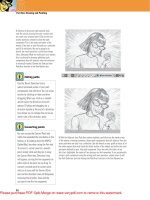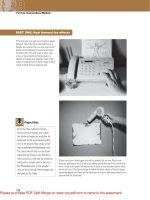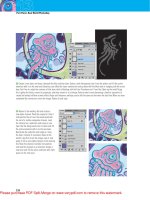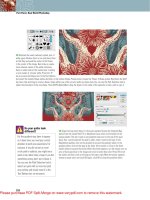Regional Anaesthesia, Stimulation, and Ultrasound Techniques (Oxford Specialist Handbooks in Anaesthesia), 1E 2
Bạn đang xem bản rút gọn của tài liệu. Xem và tải ngay bản đầy đủ của tài liệu tại đây (5.73 MB, 296 trang )
Part 3
Upper Limb
2 Interscalene brachial plexus block
22 Suprascapular nerve block
23 Supraclavicular brachial plexus block
24 Infraclavicular brachial plexus block
25 Axillary brachial plexus block
26 Mid-humeral block
27 Elbow and forearm blocks
28 Wrist, hand, and finger blocks
29 Intravenous regional anaesthesia (Bier’s block)
265
277
283
293
303
3
37
329
339
Chapter 2
Interscalene brachial
plexus block
Background 266
Peripheral nerve stimulator technique: Winnie’s approach 269
Peripheral nerve stimulator technique: Meier’s approach 270
Endpoints for nerve stimulation techniques 27
Ultrasound techniques 272
Further reading 275
265
266
CHAPTER 2 Interscalene
brachial plexus block
Background
PNS:
US:
Indications
• Anaesthesia: shoulder and/or proximal upper arm surgery. The
superficial cervical plexus may also need to be blocked for skin
anaesthesia over the shoulder (see E Superficial or subcutaneous
block of the cervical plexus: landmark technique, p. 239).
• Analgesia: postoperative pain relief for shoulder or proximal upper arm
surgery. Physiotherapy and/or mobilization (e.g. frozen shoulder) in the
shoulder region.
Introduction
The interscalene approach to the brachial plexus is principally indicated for
surgery on the shoulder as it is the only approach to the brachial plexus that
reliably blocks the suprascapular nerve, which provides sensory innervation to 70% of the shoulder joint. It has a large number of side effects and
potential complications, which makes it one of the more dangerous blocks
to perform.
The modern approach was described by Winnie in 970, as a medially directed, single-injection technique at the level of C6. However, this
approach has been criticized as it can be associated with the risk of intraforaminal needle passage and subsequent epidural/intrathecal injection, as
well as vertebral artery injection. More recently described techniques have
popularized a more lateral or parasagittal needle direction (Meier, Borgeat),
which avoids the central neuraxis and facilitates both single injection and
catheter techniques.
This block is not suitable for hand or distal arm surgery as it will not
achieve reliable blockade of the C7–T nerve roots even with excessive
volumes of LA (>40mL). There are other more reliable and safer brachial
plexus blocks for this (see Chapters 23, 24, 25, and 26).
Anatomy
• The brachial plexus is formed from the anterior rami of the spinal
nerves of C5, C6, C7, C8, and T (occasionally from C4=‘prefixed’, or
T2=‘postfixed’).
• The interscalene approach blocks the plexus at the level of the roots/
upper and middle trunks of the plexus.
• The roots emerge from between the anterior and posterior tubercles
of the transverse processes of the cervical vertebrae and descend
sandwiched between the anterior and middle scalene muscles forming
the superior trunk (C5/6), middle trunk (C7) and inferior trunk (C8,
T). See Fig. 2..
• Anatomical variation is extremely common in the interscalene region;
one or more nerve roots may pass through the anterior or middle
Background
scalene muscles, or even anterior to them. The formation of the trunks
also may occur at the any level even close to the cervical foramina.
• The vertebral artery lies anterior-medial to the plexus and is vulnerable
to intravascular injection depending upon the approach used.
• The upper and middle trunks lie superior to the subclavian artery, and the
lower trunk postero-lateral to the subclavian artery, close to the st rib.
• Relevant branches of the plexus include the suprascapular nerve
(C5/6—motor supply to supraspinatus and infraspinatus and sensory
innervation of 770% of posterior shoulder joint), and the dorsal scapular
nerve (C5—motor innervation to rhomboid muscles).
• Cutaneous innervation over the clavicle and anterior/superior aspect of
the shoulder is from the lateral and intermediate supraclavicular nerves
(C4) from the superficial cervical plexus.
Specific contraindications
• Contralateral phrenic nerve palsy
• Contralateral recurrent laryngeal nerve palsy
• Severe respiratory disease (relative).
1
4
2
3
8
5
7
6
Fig. 2. Diagram to show the brachial plexus sitting between the anterior and middle
scalene muscles, posterior to the clavicular head of the sternoclavicular muscle.
thyroid cartilage; 2 cricoid cartilage; 3 sternal head of sternocleidomastoid muscle;
4 external jugular vein; 5 clavicular head of sternocleidomastoid muscle; 6 clavicle;
7 anterior scalene muscle; 8 middle scalene muscle; Black arrow, brachial plexus.
267
268
CHAPTER 2 Interscalene
brachial plexus block
Side effects and complications
Side effects
• Hemidiaphragmatic paralysis due to phrenic nerve block is almost
universal and is accompanied by a 25–30% reduction in pulmonary
function. Caution in patients with limited respiratory reserve. The
incidence of block of the phrenic nerve may be reduced by use of lowvolume injections (<0mL), but may fail to block the superficial cervical
plexus.
• Horner’s syndrome due to stellate ganglion blockade.
• Recurrent laryngeal nerve blockade (hoarse voice).
Complications
Complications of interscalene block depend to some extent on the
approach used:
• Intrathecal, epidural, and intracord injection have all been described and
are potentially devastating.
• Vertebral artery puncture and intra-arterial injection. Seizures may occur
immediately—inject mL of LA and pause before injecting remainder in
fractionated doses.
• Neurological injury. Permanent injury is rare (0.2%), but temporary
paraesthesia, dysaesthesia, and/or pain unrelated to surgery are more
common: 8–4% incidence at 0 days, reducing to 3.7% at month, and
0.6–0.9% at 6 months. Comorbidities such as carpal tunnel syndrome,
complex regional pain syndrome, or sulcus ulnaris syndrome are
accountable for the majority of these symptoms.
• Pneumothorax (0.2%).
Clinical notes
Awake or asleep?
All the case reports of serious complications relating to injection of LA
into the central neuraxis have occurred when patients were asleep for
their block. This led to ASRA making an advisory statement that all interscalene brachial plexus blocks be performed in awake or lightly sedated
patients and should not be performed in anaesthetized patients. However,
the fault may have been in the technique, and not necessarily prevented
by the patient being awake (although it may have been recognized at the
time). In the event of a permanent neurological complication, it may be
a difficult position to defend medicolegally if the block was performed
in an anaesthetized patient. For these reason it is recommended to only
perform interscalene brachial plexus blocks on awake or lightly sedated
patients, or to document good reasons why the block was performed on
an anaesthetized patient.
PERIPHERAL NERVE STIMULATOR TECHNIQUE
Peripheral nerve stimulator technique:
Winnie’s approach
Landmarks
• Identify the posterior border of the clavicular head of the SCM muscle
(this can be made easier by asking the patient to lift their head off the
pillow).
• Immediately behind is the belly of the anterior scalene muscle.
• Moving the fingers laterally/posteriorly allows the interscalene groove
to be palpated between the anterior and middle scalene muscles.
• The groove can be made more prominent by turning the neck away
from the side of the block and asking the patient to take deep slow
breaths or sniff.
• The needle insertion point is in the interscalene groove at the level of
the cricoid cartilage (C6). Commonly the external jugular vein crosses
the interscalene groove at this level, but this is not a constant landmark.
Technique
• The patient is positioned supine with the head turned away from the
side to be blocked.
• Prepare the skin with 0.5% chlorhexidine in 70% alcohol. Wait until the
skin is dry.
• Anaesthetize the skin with a subcutaneous injection of % lidocaine at
the point of needle insertion.
• A 25–50mm 22G stimulating needle is inserted perpendicular to
the skin: this gives a medial, 745° caudad and slight dorsal angulation
(towards the contralateral elbow, when the arm lies at the patient’s
side). See Fig. 2.2.
• The plexus is a very superficial structure and is rarely >20mm deep at
this level. (The original description indicates continuing on the same
trajectory, if the plexus is not encountered, until contact with the
transverse process—this practice cannot be recommended and the needle
should not be inserted >25mm.)
• Once appropriate response to nerve stimulation is achieved (see
E Endpoints for nerve stimulation techniques, p. 27), aspirate and
disconnect to minimize risk of intravascular needle placement and inject
25–30mL of LA in 5mL aliquots. A cylindrical, ‘sausage shape’ fullness
can often be felt between the anterior and middle scalene muscles.
• Note that the needle direction is towards the midline and the centralneuraxis. The minimum distance to the intervertebral foramen is
25mm—intrathecal and intracord injections have been described with
this approach.
• The perpendicular angle of approach to the plexus makes this technique
less suited to catheter insertion.
269
270
CHAPTER 2 Interscalene
brachial plexus block
Peripheral nerve stimulator technique:
Meier’s approach
In this approach the needle is directed laterally, away from the midline, thus
reducing the chance of damage to the central neuraxis or vertebral artery
injection. In addition the tangential approach to the plexus facilitates catheter insertion.
Landmarks
• The needle insertion site is at the level of C4, marked by the thyroid
notch (72 cm above the level of the cricoid cartilage) at the posterior
edge of the SCM muscle.
• Subclavian artery in the supraclavicular fossa.
Technique
• Prepare the skin with 0.5% chlorhexidine in 70% alcohol. Wait until the
skin is dry.
• Anaesthetize the skin with a subcutaneous injection of % lidocaine at
the point of needle insertion.
• A 50mm 22G stimulating needle is directed along the interscalene
groove, with a 30° angle to the skin, in a caudad and lateral direction
towards a point just lateral to the subclavian artery pulsation. (The
subclavian artery may only be palpable in 50% of patients—in this
case use the mid-clavicular point as the lower landmark, or a Doppler
probe.)
• The plexus should be found at a depth of 3–4cm.
• Once appropriate response to nerve stimulation is achieved (see
E Endpoints for nerve stimulation techniques, p. 27), aspirate and
disconnect to minimize risk of intravascular needle placement and inject
25–30mL of LA in 5mL aliquots. A cylindrical, ‘sausage shape’ fullness
can often be felt between the anterior and middle scalene muscles.
Endpoints for nerve stimulation techniques
Endpoints for nerve stimulation
techniques
For shoulder surgery the following motor responses are acceptable with a
stimulating current of between 0.2mA and 0.5mA:
• Biceps
• Triceps
• Deltoid.
Other motor responses may be obtained and can be used as cues for needle redirection:
• Phrenic nerve: diaphragm contraction. The phrenic nerve lies on the
anterior surface of the anterior scalene muscle, and indicates too
anterior needle position—redirect more posteriorly.
• Dorsal scapular nerve: rhomboid muscle contraction—shoulder and
scapular movement. This lies posterior to the middle scalene muscle and
indicates the need for more anterior needle redirection.
• Nerve to levator scapulae: scapular and shoulder movement—anterior
and more caudad needle redirection required.
• Accessory nerve: trapezius muscle contraction—needle too cephalad and
too posterior—redirect caudad and anteriorly.
Fig. 2.2 Winnie’s approach to the interscalene brachial plexus block. The fingers of
the left hand are palpating the interscalene groove and the needle is inserted at the
level of C6, aiming towards the contralateral elbow.
271
272
CHAPTER 2 Interscalene
brachial plexus block
Ultrasound techniques
Preliminary scan
• Well-defined landmarks. The plexus being so superficial and the
sensitive surrounding anatomy make this an attractive block to perform
with US. However, a systematic approach to identifying the plexus and
surrounding structures is important. This can be done scanning from the
midline postero-laterally, or scanning proximally, up the neck from the
supraclavicular fossa.
• Scanning from medial to lateral; identify the trachea, thyroid gland,
carotid artery, and internal jugular vein. The SCM muscle is seen
superficial to the artery and vein. Moving the probe posteriorly the first
muscle seen deep to the flattened lateral tail of SCM is the anterior
scalene muscle. The brachial plexus can be identified posterior to this
between the anterior and middle scalene muscles.
• Scanning from the supraclavicular fossa cephalad; place the probe
parallel to and behind the clavicle in the supraclavicular fossa. Identify
the subclavian artery (pulsatile, anechoic) and the trunks /divisions of
the brachial plexus superior/posterior/lateral to the artery (‘bunch
of grapes’ appearance). Then scan cephalad to follow the nerves
proximally, with the anterior and middle scalene muscles becoming
visible on either side.
• At this level the nerves of the plexus appear as hypoechoic, round, or
oval structures (see Fig. 2.3). It is important to angle the probe slightly
caudad as the nerves are passing laterally towards the st rib following
the scalene muscles.
• Usually the more superficial roots are the more proximal ones. If the
lower nerve roots (C8, T) are visible, then scan more proximally.
• The phrenic nerve can also be seen close to the C5 nerve root, lying on
the anterior scalene beneath the prevertebral fascia that encloses both
the muscle and the interscalene groove. The suprascapular artery also
can be seen crossing the anterior scalene at this level.
• It is useful to identify the deeper structures; the transverse processess
of the vertebrae, and observe the nerve roots entering/exiting their
respective intervertebral foramina. Also identifty the vertebral artery
on the lateral aspect of the vertebral bodies anterior to the emerging
nerve roots inbetween the transerve foramina of the upper 6 cervical
verabrae.
US settings
• Probe: high-frequency (>0MHz) linear L38 broadband probe.
• Settings: MB—resolution.
• Depth: 2–3cm.
• Orientation: axial with caudad angulation.
• Needle: 25–50mm of choice.
Ultrasound techniques
SCM
Posterior/lateral
Anterior/medial
MS
AS
TP
Fig. 2.3 Ultrasound of the brachial plexus in the interscalene groove. SCM,
sternocleidomastoid muscle; MS, middle scalene muscle; White arrows, nerve roots
of the brachial plexus; AS, anterior scalene muscle; Black arrow, vertebral artery; TP,
tip of transverse process.
Technique
• Position the patient supine with the head turned 45° to the contralateral
side. A lateral position (block side up) can be used, which can facilitate an
in-plane lateral approach (machine in front of patient and operator behind).
• Either an in-plane or out-of-plane approach may be used. The in-plane
approach can be performed either from medially (passing through
anterior scalene) or laterally (passing through middle scalene), see
Fig. 2.4. The out-of-plane approach mimics the Meier’s insertion and
facilitates both familiarity and catheter placement.
• Prepare the skin with 0.5% chlorhexidine in 70% alcohol. Wait until the
skin is dry.
• Anaesthetize the skin with a subcutaneous injection of % lidocaine at
the point of needle insertion.
• Insert needle to the side of the plexus alongside C5 or C6.
• For shoulder surgery only the C5 and C6 nerve roots need to be blocked
and performing the block proximally should ensure blockade of the
suprascapular nerve (and dorsal scapular nerve) before they leave the
plexus.
• After negative aspiration inject LA in small (–2mL) aliquots and observe
spread. The needle may need to be repositioned to the other side of
the plexus.
• With US, small volumes of LA (5–0mL) targeted around the C5 and
C6 nerve roots appear sufficient for postoperative pain relief, but
may not spread to adequately block the superficial cervical plexus that
innervates the skin over the shoulder and this may need to be blocked
separately (see E Superficial or subcutaneous block of the cervical
plexus: landmark technique, p. 239).
273
274
CHAPTER 2 Interscalene
brachial plexus block
Fig. 2.4 Set up for a lateral in-plane approach for an ultrasound-guided interscalene
brachial plexus block.
Further reading
Further reading
Benumof JL (2000). Permanent loss of cervical spinal cord function associated with interscalene block
performed under general anesthesia. Anesthesiology, 93(6), 54–4.
Fredrickson MJ, Kilfoyle DH (2009). Neurological complication analysis of 000 ultrasound guided
peripheral nerve blocks for elective orthopaedic surgery: a prospective study. Anaesthesia, 64(8),
836–44.
Gautier P, Vandepitte C, Ramquet C, et al. (20). The minimum effective anesthetic volume of
0.75% ropivacaine in ultrasound-guided interscalene brachial plexus block. Anesth Analg, 3(4),
95–5.
Riazi S, Carmichael N, Awad I, et al. (2008). Effect of local anaesthetic volume (20 vs 5 mL) on the
efficacy and respiratory consequences of ultrasound-guided interscalene brachial plexus block. Br
J Anaesth, 0(4), 549–56.
Sardesai, AM, Patel R, Denny NM, et al. (2006). Interscalene brachial plexus block: can the risk of
entering the spinal canal be reduced? A study of needle angles in volunteers undergoing magnetic
resonance imaging. Anesthesiology, 05(), 9–3.
275
Chapter 22
Suprascapular
nerve block
Background 278
Peripheral nerve stimulator technique 279
Ultrasound technique 280
Further reading 282
277
278
CHAPTER 22 Suprascapular
nerve block
Background
PNS:
US:
Indications
• Analgesia for shoulder surgery (where an interscalene brachial plexus
block is unsuccessful or inadvisable).
Anatomy
• The suprascapular nerve arises from the upper trunk of the brachial
plexus (C5, C6).
• It crosses the posterior triangle of the neck deep and parallel to the
inferior belly of omohyoid then passes under trapezius muscle.
• It passes through the scapular notch, below the suprascapular ligament
into the supraspinatous fossa.
• It supplies supraspinatous, infraspinatous and sensation to the shoulder
and acromioclavicular joints.
• The suprascapular artery enters the suprascapular fossa by passing over
the suprascapular ligament.
Side effects and complicatios
Complications
• Rarely pneumothorax.
Peripheral nerve stimulator technique
Peripheral nerve stimulator technique
Landmarks
• Midpoint of the spine of the scapula.
• Inferior angle of the scapula.
Technique
• Position the patient sitting or lateral (operative side uppermost),
with hand on the opposite shoulder.
• Mark the midpoint of the spine of the scapula.
• Draw a line from the inferior angle of the scapula to the midpoint of
the spine and then mark a point cm more cranially. This is the needle
insertion point. See Fig. 22..
• Prepare the skin with 0.5% chlorhexidine in 70% alcohol. Wait until the
skin is dry.
• Anaesthetize the skin with a subcutaneous injection of % lidocaine at
the point of needle insertion.
• Insert a 22G 50mm stimulating needle perpendicular to the skin in all
planes (transverse, with caudad and slight medial angulation).
• Advance anteriorly looking for abduction or external rotation of the
shoulder.
• The needle is cautiously repositioned to achieve a threshold current of
0.3–0.5mA and after negative aspiration 0–5mL of LA are injected in
fractionated doses.
1
2
5
3
4
Fig. 22. Landmarks for suprascapular nerve block. clavicle; 2 suprascapular
nerve; 3 humerus; 4 inferior angle of scapula; 5 spine of scapula; White arrow,
suprascapular notch; Black arrow, midpoint of spine of scapula.
279
280
CHAPTER 22 Suprascapular
nerve block
Ultrasound technique
Preliminary scan
• Position the patient sitting or lateral (operative side uppermost), with
hand on the opposite shoulder.
• Place the transducer above the midpoint and parallel to the spine of the
scapula. Angle the probe markedly caudally, almost in a coronal plane.
See Fig. 22.2.
• Identify the trapezius muscle and deep to this the supraspinatous
muscle, sitting on the scapula.
• The scapular notch can be identified as a depression in the contour of
the scapular cortex. See Fig. 22.3.
• The suprascapular ligament can often be seen covering over this
depression.
• The nerve can sometime be visualized beneath the ligament in the
scapular notch. As it is travelling in an oblique direction it can be hard
to get a good image of the nerve and gentle rotational and tilting
movements may be needed.
• Try to identify the suprascapular artery (anechoic, pulsatile) with the
Doppler. This is usually lateral to the nerve and above the suprascapular
ligament.
US settings
• Probe: medium/high-frequency linear L38 broadband probe.
• Settings: MB—general/resolution.
• Depth: 3–6cm.
• Orientation: coronal/transverse with marked caudal angulation.
• Needle: 50–80mm short bevelled.
Technique
• Identify the structures described earlier.
• Prepare the skin with 0.5% chlorhexidine in 70% alcohol. Wait until the
skin is dry.
• Anaesthetize the skin with a subcutaneous injection of % lidocaine at
the point of needle insertion.
• Use an in-plane approach from medial to lateral.
• After careful aspiration inject 5mL of LA around the nerve.
• If the nerve is not clearly seen, inject the LA below supraspinatus muscle
on the floor of the suprascapular fossa. LA will spread to block the
nerve.
Ultrasound technique
2
1
Fig. 22.2 Set up for a suprascapular ultrasound-guided nerve block. inferior angle
of scapula; 2 spine of scapula.
TM
Lateral
Medial
SM
Fig. 22.3 Ultrasound of the suprascapular notch. TM, trapezius muscle; SM,
supraspinatous muscle; White triangles, scapula; Black arrow, suprascapular ligament;
White arrow, scapular notch.
281
282
CHAPTER 22 Suprascapular
nerve block
Further reading
Harmon D, Hearty C (2007). Ultrasound-guided suprascapular nerve block technique. Pain Physician,
0(6), 743–6.
Chapter 23
Supraclavicular brachial
plexus block
Background 284
Peripheral nerve stimulator technique 286
Ultrasound technique 288
Further reading 292
283
284
CHAPTER 23 Supraclavicular
brachial plexus block
Background
PNS:
US:
Indications
• Anaesthesia: any surgery of the upper limb and hand.
• Analgesia: postoperative analgesia for surgery of the upper limb or
hand.
Introduction
The supraclavicular block approaches the brachial plexus at about the same
level as the vertical infraclavicular approach. As such, LA is injected around
the narrowest part of the plexus and has the fastest onset of brachial plexus
blocks. This has led to it being described as the ‘spinal of the arm’.
Kulenkampff is said to have carried out the first percutaneous supraclavicular block on himself in 9 (Hirschel had published a surgical approach
prior to this). Kulenkampff ’s technique described inserting a needle above
the midpoint of the clavicle where the subclavian pulse could be felt and the
needle aimed at the spinous process of T2. This allowed LA to be deposited
on the brachial plexus at the level of the trunks with fast onset of a dense
and widespread block. However, it carried an unacceptable risk of pneumothorax. Brown published the ‘plumb-bob’ technique in 993.
Anatomy
• The subclavian artery arches over the st rib immediately posterior to
the insertion of anterior scalene muscle to the st rib.
• The brachial plexus, just above the st rib, lies postero-lateral to the
subclavian artery. The middle scalene muscles lie further posterior, also
inserting onto the st rib. See Fig. 23..
• The roots of C5 through to T join together to form the trunks and
divide into anterior and posterior divisions. These changes produce a
US picture similar to a ‘bunch of grapes’ sitting on the st rib.
• At this point the suprascapular nerve and the long thoracic nerve have
often already left the perivascular sheath. Therefore this is not an ideal
approach for shoulder surgery.
Side effects and complications
Side effects
• Horner’s syndrome and recurrent laryngeal nerve palsy. These side
effects are less likely than with interscalene approaches.
Background
Complications
• Pneumothorax is the most feared complication from this procedure.
The rate should be <:000 (0.%) in experienced hands for landmark
techniques.
• Arterial puncture (20% for landmark techniques).
• Intravascular injection.
• Haematoma.
1
2
3
5
4
Fig. 23. Illustration of the brachial plexus emerging from between the scalene
muscle to join the subclavian artery resting on the st rib, behind the clavicle. st
rib; 2 clavicle; 3 subclavian vein; 4 anterior scalene muscle; 5 middle scalene muscle;
White arrow, subclavian artery; Black arrow, brachial plexus.
285
286
CHAPTER 23 Supraclavicular
brachial plexus block
Peripheral nerve stimulator technique
The commonest current technique is a modification of Brown’s, described
by Winnie. Also known as the subclavian perivascular block.
Landmarks
• Interscalene groove
• Subclavian artery.
Technique
• The patient lies supine with the head turned slightly to the opposite side
to that being blocked.
• The interscalene groove is palpated as for an interscalene block
at the level of C6 (cricoids cartilage). The lateral border of
sternocleidomastoid is palpated. As the operator’s finger slides off the
posterior border, the anterior scalene muscle is found.
• The operator’s finger is slid down the interscalene groove till the
supraclavicular area flattens out and the subclavian pulse can be
palpated.
• Prepare the skin with 0.5% chlorhexidine in 70% alcohol. Wait until the
skin is dry.
• Anaesthetize the skin with a subcutaneous injection of % lidocaine at
the point of needle insertion.
• The interscalene groove may be lost by the traversing omohyoid
muscle.
• The subclavian pulse is also not palpable in all patients.
• At the lowest point that the interscalene groove is palpated, a shortbevelled needle is inserted posterior and medial to the palpating finger
in a caudad direction towards the ipsilateral great toe. See Fig. 23.2.
• The needle should never be directed medially (keep the hub of the
needle against the side of the neck).
• Stimulation of the plexus should give wrist or finger flexion/extension. If
no stimulation is found, carefully redirect the needle in the same caudal
direction, but from a more anterior, then posterior starting point. If the
artery is punctured move more posteriorly.
• Manipulate the needle until stimulation is produced between 0.3mA and
0.5mA. Disconnect syringe before injection to exclude passive reflux
of blood and inject 5mL aliquots of LA, aspirating regularly to exclude
intravascular injection.
• Use about 0.5mL/kg up to 40mL.
Clinical notes
• As the lower trunk of the plexus tends to sit close to the subclavian
artery on the st rib it is less reliably blocked. This results in sparing
of C8/T nerve roots /ulnar nerve (the medial side of the hand and
forearm).
Peripheral nerve stimulator technique
Fig. 23.2 Winnie’s subclavian perivascular approach. The middle finger of the left
hand is on the subclavian artery.
287









